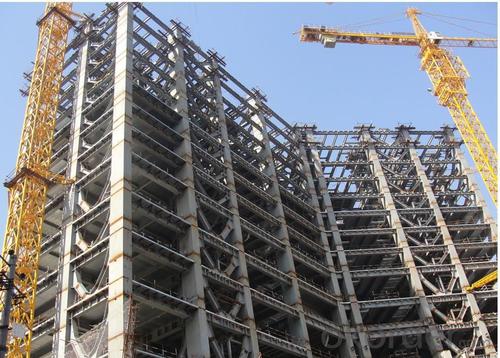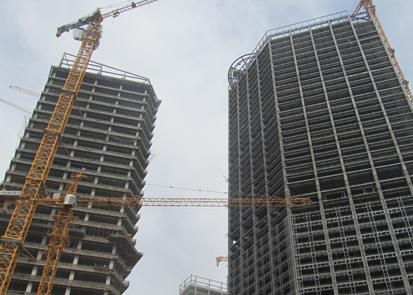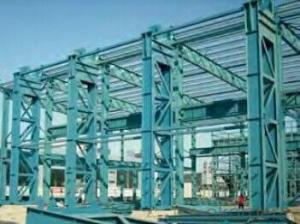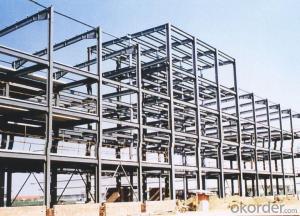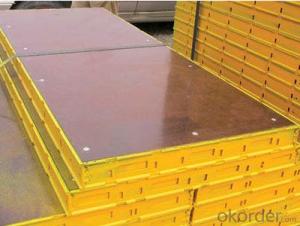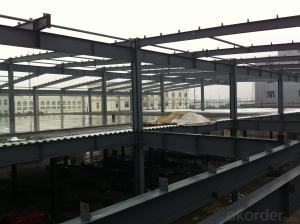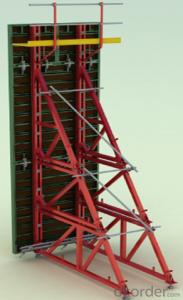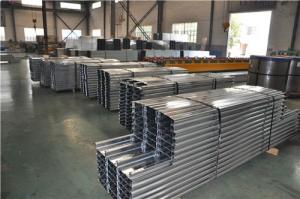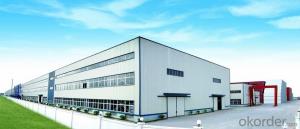Steel Building Construction
- Loading Port:
- Tianjin Port
- Payment Terms:
- TT or LC
- Min Order Qty:
- 1 set m.t.
- Supply Capability:
- 5000MTONS/ Month m.t./month
OKorder Service Pledge
OKorder Financial Service
You Might Also Like
Specifications of steel building construction
Project type: Center building, high-rise building, office building and shopping mall
Building area: 540000 sqm
Height: 206m
Steel material: Q345B
Steel dosage: 25000 t
Structure type: Box column-frame beam, support structure;
The biggest steel plate thickness: 100 mm
|
Grade |
Chemical compositions | ||||
|
C |
Mn |
MAXIMUM(≤) | |||
|
Si |
S |
P | |||
|
Q345B |
≤0.2 |
1.00-1.60 |
0.55 |
0.04 |
0.04 |
|
Mechanical Properties | |||||
|
Yield point |
tensile strength |
Elongation | |||
|
16mm max |
16-40mm | ||||
|
345 |
325 |
470-630 |
21 | ||
1. GB standard material
2. High Structural safety and reliability
3. The production can reach GB/JIS/ISO/ASME standard
Packaging & Delivery of steel building construction
1. According to the project design and the component size, usually the main component parts are nude packing and shipped by bulk vessel. And the small parts are packed in box or suitable packages and shipped by containers.
2. This will be communicated and negotiated with buyer according to the design.
Engineering Design Software of steel building construction
Tekla Structure \ AUTO CAD \ PKPM software etc
⊙Complex spatial structure project detailed design
⊙Construct 3D-model and structure analysis. ensure the accuracy of the workshop drawings
⊙Steel structure detail ,project management, automatic Shop Drawing, BOM table automatic generation system.
⊙Control the whole structure design process, we can obtain higher efficiency and better results
Technical support of steel building construction
|
Worker |
Rate of frontline workers with certificate on duty reaches 100% |
|
Welder |
186 welders got AWS & ASME qualification 124 welders got JIS qualification 56 welders got DNV &BV qualification |
|
Technical inspector |
40 inspectors with UT 2 certificate 10 inspectors with RT 2 certificate 12 inspectors with MT 2 certificate 3 inspectors with UT3 certificate |
|
Engineer |
21 engineers with senior title 49 engineers with medium title 70 engineers with primary title. 61 First-Class Construction Engineers 182 Second-Class Construction Engineers |
|
International certification |
10 engineers with International Welding engineer, 8 engineers with CWI. |
Production Flow of steel structure/steel frame/steel construction
Material preparation—cutting—fitting up—welding—component correction—rust removal—paint coating—packing—to storage and transportation (each process has the relevant inspection)
Usage/Applications of steel structure/steel frame/steel construction
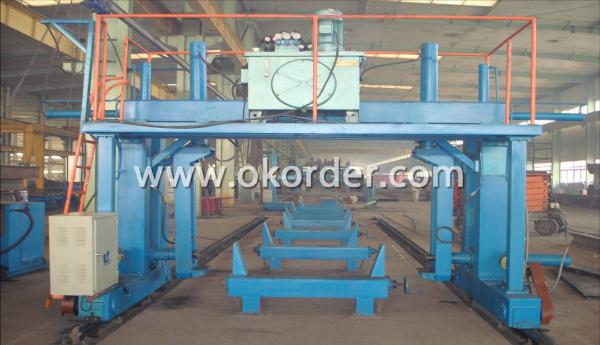
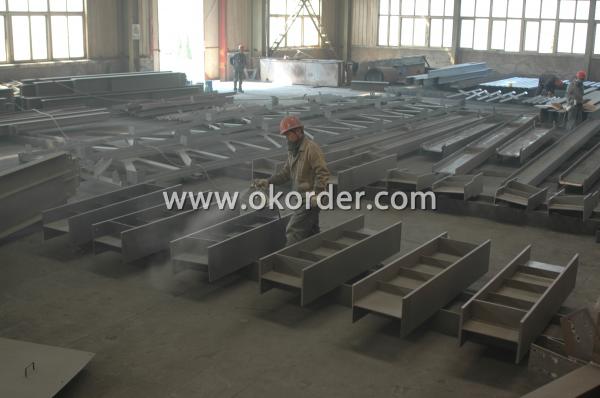
*Characters of Structure Steel
1. Steel is characterized by high strength, light weight, good rigidity, strong deformation capacity, so it is suitable for construction of large-span, super high and super-heavy buildings particularly;
2. It with good homogeneous and isotropic, is an ideal elastomer which perfectly fits the application of general engineering;
3. The material has good ductility and toughness, so it can have large deformation and it can well withstand dynamic loads;
4. Steel structure’s construction period is short;
5. Steel structure has high degree of industrialization and can realize-specialized production with high level of mechanization.
*Steel structure application
1. Heavy industrial plants: relatively large span and column spacing; with a heavy duty crane or large-tonnage cranes; or plants with 2 to 3 layers cranes; as well as some high-temperature workshop should adopt steel crane beams, steel components, steel roof, steel columns, etc. up to the whole structure.
2. Large span structure: the greater the span of the structure, the more significant economic benefits will have by reducing the weight of the structure
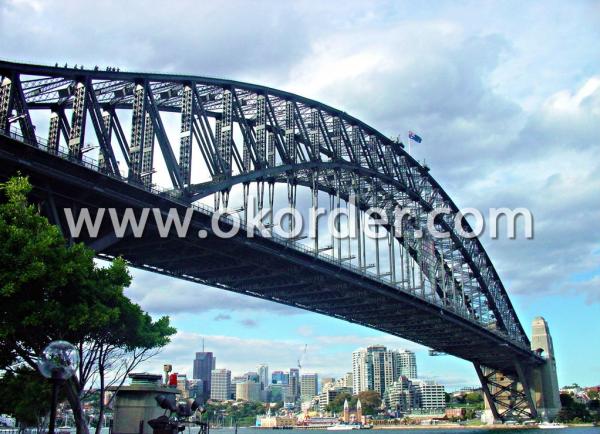
3. Towering structures and high-rise buildings: the towering structure, including high-voltage transmission line towers, substation structure, radio and television emission towers and masts, etc. These structures are mainly exposed to the wind load. Besides of its light weight and easy installation, structure steel can bring upon with more economic returns by reducing the wind load through its high-strength and smaller member section.
4. Structure under dynamic loads: As steel with good dynamic performance and toughness, so it can be used directly to crane beam bearing a greater or larger span bridge crane
5. Removable and mobile structures: Structure Steel can also apply to movable Exhibition hall and prefabricated house etc by virtue of its light weight, bolt connection, easy installation and uninstallation. In case of construction machinery, it is a must to use structure steel so as to reduce the structural weight.
6. Containers and pipes: the high-pressure pipe and pipeline, gas tank and boiler are all made of steel for the sake of its high strength and leakproofness
7. Light steel structure: light steel structures and portal frame structure combined with single angle or thin-walled structural steel with the advantages of light weight, build fast and steel saving etc., in recent years has been widely used.
8. Other buildings: Transport Corridor, trestle and various pipeline support frame, as well as blast furnaces and boilers frameworks are usually made of steel structure.
All in all, according to the reality, structure steel is widely used for high, large, heavy and light construction.
- Q: How are steel structures used in access and safety systems?
- Steel structures are widely used in access and safety systems due to their strength, durability, and versatility. They provide a reliable and sturdy framework for various access and safety equipment, ensuring the safety and well-being of workers and individuals. One common application of steel structures in access and safety systems is in the construction of platforms and walkways. Steel platforms are often used in industrial settings to provide safe and secure access to elevated areas, such as machinery, storage tanks, or roof spaces. These platforms are typically made of steel beams, columns, and grating, which can support heavy loads and withstand harsh environmental conditions. By using steel structures, access to these elevated areas becomes much safer and more efficient. Another important use of steel structures in access and safety systems is in the construction of staircases and ladders. Steel staircases are commonly found in commercial buildings, factories, and construction sites, providing a reliable means of vertical access for workers and visitors. Steel ladders are also widely used in various industries, including manufacturing, transportation, and utilities, allowing workers to safely access elevated areas or confined spaces. Furthermore, steel structures are essential for the installation of safety equipment such as guardrails and handrails. These safety features are crucial for preventing falls and providing stability for individuals working at heights or on elevated platforms. Steel guardrails and handrails offer superior strength and durability, ensuring the protection of workers and complying with safety regulations. In addition to their use in access and safety systems, steel structures are also employed in the construction of safety barriers and fencing. These barriers serve as a protective measure to prevent unauthorized access to restricted areas or hazardous zones. Steel barriers are known for their robustness and resistance to impact, making them an ideal choice for applications where high-security and safety are essential. Overall, steel structures play a vital role in access and safety systems by providing a reliable framework for various equipment and safety features. Their strength, durability, and versatility make them the preferred choice in industries where safety is paramount.
- Q: What are the considerations for designing steel staircases?
- When designing steel staircases, there are several important considerations to take into account. Firstly, it is essential to consider the intended use and occupancy of the staircase. Will it be used by a large number of people on a daily basis, or will it be primarily for occasional use? The expected foot traffic will impact the design, as more heavily used staircases will require greater durability and stability. Another key consideration is the location and surroundings of the staircase. Will it be situated indoors or outdoors? Will it be exposed to harsh weather conditions or chemicals? These factors will influence the choice of materials, finishes, and coatings to ensure the staircase's longevity and resistance to corrosion or degradation. The dimensions and layout of the staircase should also be carefully considered. The rise and run of each step, as well as the overall height and width of the staircase, must comply with relevant building codes and regulations to ensure the safety and comfort of users. The dimensions should be optimized to provide an ergonomic and user-friendly experience. In addition, the aesthetic considerations should not be overlooked. The design of the steel staircase should complement the overall style of the building or space and align with the desired architectural vision. The choice of handrails, balustrades, and finishes should be selected to enhance the visual appeal of the staircase while maintaining functionality. Structural integrity is of utmost importance in designing steel staircases. The load-bearing capacity of the staircase must be carefully calculated to accommodate the expected live loads, including the weight of people, furniture, or other items that may be transported on the stairs. The choice of steel materials and reinforcements should be made to ensure the structural stability and safety of the staircase. Lastly, it is crucial to consider accessibility requirements. The design should incorporate features that facilitate easy and safe access for individuals with disabilities, such as installing handrails at appropriate heights and providing sufficient space for wheelchair users to maneuver. In conclusion, designing steel staircases requires careful consideration of factors such as usage, location, dimensions, aesthetics, structural integrity, and accessibility. By addressing these considerations, one can create a well-designed steel staircase that meets safety standards, withstands environmental conditions, and enhances the overall design of the space.
- Q: How are steel structures designed to resist fire and heat?
- Steel structures are designed to resist fire and heat through various measures such as using fire-resistant coatings, implementing compartmentalization, using fire-resistant materials for insulation, and incorporating structural fire protection systems. These measures help to slow down the spread of fire, maintain structural integrity, and ensure the safety of occupants during a fire event.
- Q: What are the factors to consider when designing steel structures for open spaces and stadiums?
- There are several factors that require careful consideration when designing steel structures for open spaces and stadiums. These factors encompass: 1. Load-bearing capacity: Steel structures must be capable of supporting the weight of the intended load, including the roof, seating, and any suspended equipment. The structural design must withstand the forces exerted by wind, snow, and other environmental conditions. 2. Span and column spacing: The span and column spacing of the steel structure play a crucial role in determining overall stability and rigidity. Sufficient spacing ensures effective load distribution and minimal deflection. 3. Aesthetics: Open spaces and stadiums often serve as architectural landmarks, so the design of the steel structure should be visually appealing and harmonious with the surrounding environment. Considerations may include materials, color schemes, and architectural style. 4. Accessibility and safety: The design must account for the safety and accessibility needs of users. This involves proper stairways, handrails, emergency exits, and compliance with building codes and regulations for fire safety and crowd management. 5. Durability and maintenance: Steel structures should be designed to withstand the test of time and require minimal maintenance. This entails selecting appropriate coatings and finishes to protect against corrosion and environmental factors. 6. Cost: Cost considerations are crucial in any construction project. The design should strike a balance between desired aesthetics, functionality, and the available budget. 7. Functional requirements: The design should address the specific functional requirements of the open space or stadium, including seating capacity, sightlines, acoustics, and the integration of lighting, audiovisual systems, and other necessary infrastructure. 8. Environmental impact: Sustainable design principles should be incorporated into the design of steel structures for open spaces and stadiums. This includes energy-efficient features, the use of recycled materials, and the potential for future expansion or adaptive reuse. By carefully considering these factors, designers can create steel structures that are not only safe and functional but also visually appealing, durable, and environmentally responsible.
- Q: What are the different types of steel framing systems?
- There are several different types of steel framing systems, including light gauge steel framing, structural steel framing, and cold-formed steel framing. Light gauge steel framing is commonly used in residential and commercial buildings, consisting of thin steel sheets formed into studs and tracks. Structural steel framing, on the other hand, is used in large-scale industrial and commercial projects, utilizing heavy steel beams and columns for structural support. Lastly, cold-formed steel framing involves bending and shaping thin steel sheets into structural members, commonly used in non-load-bearing walls and partitions.
- Q: How are steel structures fabricated?
- Steel structures are fabricated through a process known as steel fabrication, which involves cutting, shaping, and assembling steel components to create a desired structure. This typically includes processes such as cutting steel plates and beams, welding or bolting them together, and applying protective coatings. Advanced technology like computer-aided design (CAD) and computer numerical control (CNC) machines are often used to ensure precision and efficiency in the fabrication process.
- Q: What are the factors to consider when designing steel structures for architectural flexibility?
- When designing steel structures for architectural flexibility, there are several factors that need to be considered. Firstly, the load-bearing capacity of the steel structure should be carefully calculated to ensure that it can support any changes or additions to the architectural layout. Additionally, the ease of modification and adaptability of the steel structure should be evaluated, as it should allow for future alterations without compromising its integrity. The choice of connections and joints is also crucial, as they should be designed to allow for flexibility while maintaining structural stability. Moreover, the overall aesthetic appeal and architectural vision should be taken into account during the design process to ensure that the steel structure complements the desired architectural flexibility.
- Q: What are the different types of steel trusses used in building structures?
- There are several different types of steel trusses commonly used in building structures, including Warren trusses, Pratt trusses, Howe trusses, and K-trusses. Each of these truss types has its own unique design and characteristics, which make them suitable for different types of buildings and structural requirements.
- Q: How are steel structures used in the construction of exhibition centers?
- Steel structures are commonly used in the construction of exhibition centers due to their strength, durability, and flexibility. Steel beams and columns provide the necessary support for large, open spaces, allowing for the creation of expansive exhibition halls and atriums. The versatility of steel allows for the construction of complex architectural designs, including curved and cantilevered structures, that can enhance the visual appeal of exhibition centers. Additionally, steel's fire-resistant properties make it a safe choice for buildings that accommodate a large number of people.
- Q: What is the difference between a steel structure and a steel warehouse?
- A steel structure refers to a construction made entirely or primarily out of steel, which can include buildings, bridges, or other infrastructure. On the other hand, a steel warehouse specifically refers to a building designed and constructed for storing goods or materials, typically made out of steel for its durability and strength. In summary, a steel structure is a broader term encompassing various steel constructions, while a steel warehouse is a specific type of steel structure designed for storage purposes.
1. Manufacturer Overview
| Location | SHANDONG,China |
| Year Established | 2008 |
| Annual Output Value | Above US$20 Billion |
| Main Markets | WEST AFRICA,INDIA,JAPAN,AMERICA |
| Company Certifications | ISO9001:2008;ISO14001:2004 |
2. Manufacturer Certificates
| a) Certification Name | |
| Range | |
| Reference | |
| Validity Period |
3. Manufacturer Capability
| a) Trade Capacity | |
| Nearest Port | TIANJIN PORT/ QINGDAO PORT |
| Export Percentage | 0.6 |
| No.of Employees in Trade Department | 3400 People |
| Language Spoken: | English;Chinese |
| b) Factory Information | |
| Factory Size: | Above 150,000 square meters |
| No. of Production Lines | Above 10 |
| Contract Manufacturing | OEM Service Offered;Design Service Offered |
| Product Price Range | Average, High |
Send your message to us
Steel Building Construction
- Loading Port:
- Tianjin Port
- Payment Terms:
- TT or LC
- Min Order Qty:
- 1 set m.t.
- Supply Capability:
- 5000MTONS/ Month m.t./month
OKorder Service Pledge
OKorder Financial Service
Similar products
Hot products
Hot Searches
Related keywords



